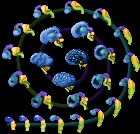Low Tech Magazine presented the article titled “The monster footprint of digital technology” in which they show how the power consumption of our high-tech machines and devices is hugely underestimated:
When we talk about energy consumption, all attention goes to the electricity use of a device or a machine while in operation. A 30 watt laptop is considered more energy efficient than a 300 watt refrigerator. This may sound logical, but this kind of comparison does not make much sense if you don’t also consider the energy that was required to manufacture the devices you compare. This is especially true for high-tech products, which are produced by means of extremely material- and energy-intensive manufacturing processes… The energy consumption of electronic devices is skyrocketing…There are multiple reasons for the growing energy consumption of electronic equipment; more and more people can buy gadgets, more and more gadgets appear, and existing gadgets use more and more energy (in spite of more energy efficient technology – the energy efficiency paradox described here before).
However, most of the energy involved in electronics is not much about their use. Larger amounts of energy are being used for the production of the technology, the embodied energy.
The energy used to produce electronic gadgets is considerably higher than the energy used during their operation. For most of the 20th century, this was different; manufacturing methods were not so energy-intensive…Advanced digital technology has turned this relationship upside down. A handful of microchips can have as much embodied energy as a car… The embodied energy of the memory chip (of a computer) alone already exceeds the energy consumption of the laptop during its life expectancy of 3 years.
The trend in the manufacture of electronics is going toward more energy-intensive processes and heavier costs in terms of raw materials and resources. Did the fast development in computer processing speed and memory, coupled with the huge amount of energy needed for manufacturing them make them faster and more productive? Every Windows user knows that after one or two years of use the operating system becomes cluttered and slows down considerably.
Defragmenting the hard disk, cleaning the registry and uninstalling applications have little effect. The cooling fan runs often, often the hard disk works like hell with no apparent reason, operations get slower and slower. This can be blamed on the poorly-engineered Windows operating system, but even alternatives like Apple or Linux, though better, don’t come any closer to match the development in hardware at the software level
Low Tech Magazine ha presentato l’articolo dal titolo “The monster footprint of digital technology” (La mostruosa impronta ecologica delle tecnologie digitali). in cui mostrano come il consumo di energia dei nostri strumenti ad alta tecnologia è fortemente sottostimato:
Quando parliamo di consumo di energia, tutta l’attenzione va verso l’utilizzo di elettricità di un dispositivo o di una macchina mentre sta operando. Un laptop da 30 watt viene considerato energeticamente meno dispendioso di un frigorifero da 300 watt. Questo può apparire logico, ma questo tipo di confronto non ha molto senso se non si considera anche l’energia che è stata utilizzata per costruire i due oggetti che vengono confrontati. Questo è particolarmente vero per i prodotti ad alta tecnologia, che vengono prodotti da processi che sono altamente intensivi per quanto riguarda l’utilizzo di energia e di materie prime… Il consumo di energia degli strumenti elettronici sale alle stelle… Ci sono diverse ragioni alla base della crescita dei consumi energetici degli strumenti elettronici; sempre più persone possono comprare i gadget, sempre più gadget entrano sul mercato, e quelli esistenti usano sempre più energia (nonostante le tecnologie siano sempre più efficienti in termini di energia utilizzata – il paradosso dell’efficienza energetica qui descritto).
Nonostante ciò, la maggior parte dell’energia richiesta dall’elettronica non riguarda più di un tanto il suo utilizzo. Quantità maggiori di energia vengono usate per la produzione della tecnologia, l’energia incorporata.
L’energia utilizzata per produrre i gadget elettronici è molto maggiore di quella utilizzata durante le loro operazioni. Per la maggior parte del ventesimo secolo le cose erano diverse; i metodi di produzione non erano così energeticamente intensivi… La tecnologia digitale avanzata ha ribaltato i termini di questa relazione. Una manciata di microchip può avere un’energia incorporata pari a quella di un’automobile… L’energia incorporata del solo chip di memoria di un computer supera l’energia utilizzata dal laptop durante tutta la sua aspettativa di vita di 3 anni.
La tendenza produttiva nell’elettronica va verso processi a uso intensivo di energia e a costi più alti in termini di materie prime e di risorse utilizzate. Ha lo sviluppo rapido della velocità di elaborazione e della quantità di memoria, accoppiate con l’enorme quantità di energie necessaria per la produzione, portato ad una maggiore velocità e produttività degli stessi? Qualsiasi utente Windows sa che dopo uno o due anni di utilizzo, il sistema operativo diventa “ingolfato” e rallenta notevolmente.
Deframmentare il disco rigido, ripulire il registro di sistema e disinstallare le applicazioni hanno poco effetto. La ventola di raffreddmento si attiva più frequentemente, spesso il disco rigido lavora come un pazzo senza una ragione evidente e le operazioni diventano sempre più lente. Ce la possiamo prendere con il sistema operativo Windows, progettato in modo non efficiente, ma anche le alternative come Apple o Linux, anche se migliori, non corrispondono a livello di software agli sviluppi dell’hardware. Leggi tutto “Those Tiny Chips With Huge Smelly Footprints
Quei piccoli chip con quelle enormi impronte puzzolenti“




